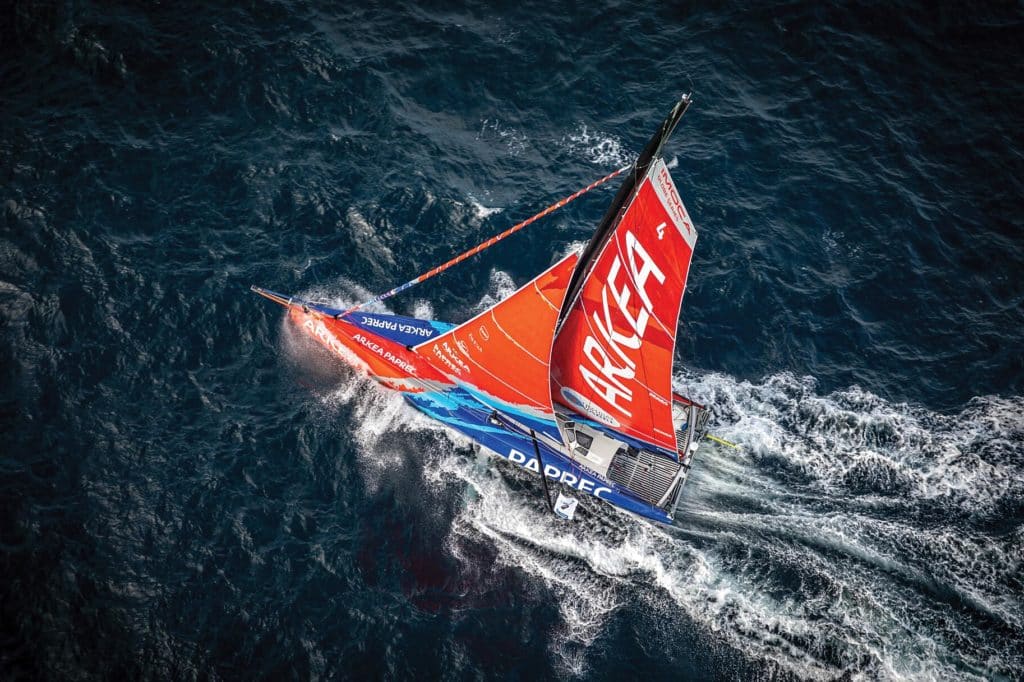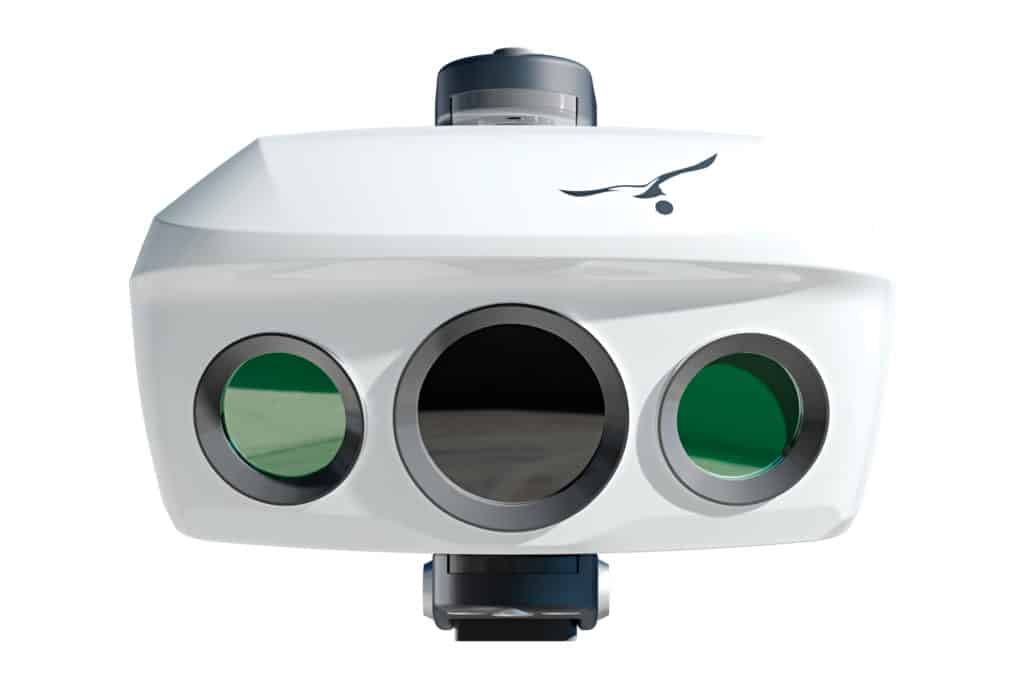
The first lesson I learned about Pacific Northwest sailing after moving here in 2009 was that Puget Sound doesn’t get much breeze in the summer. The second lesson was that it’s crucial to keep a constant vigil for logs, large branches and deadheads, which are logs or entire trees (and root balls) that have taken on so much water, they float vertically, often revealing only a few inches of freeboard. These deadheads can wreak havoc on hulls. Eleven years in, I’ve had numerous close calls, and I try not to think about the near misses that undoubtedly unfurled outside of my awareness bubble.
A lot more people these days are experiencing those near misses because the things people are doing with modern vessels involve faster speeds, often in places where an increasing number of hazards exist. There’s more global shipping (read: lots of heavy metal and more lost shipping containers) and more cruisers exploring high latitudes (read: icebergs and bergy bits). Hydrofoil-borne racing yachts, including IMOCA 60s and the 100-plus-foot Ultim trimarans, regularly exceed 30 knots and 45 knots, respectively—speeds that reduce reaction time if a crewmember spots something in the water. Even “average” cruising yachts sail faster today than years ago, thanks to progressively longer waterlines, modern sail plans and improved weather-routing capabilities.
One product developed to address the needs of these mariners is BSB Marine’s Oscar collision-avoidance system. It employs daylight and thermal-imaging cameras, artificial intelligence, deep learning and machine vision to make yachtsmen aware of navigational hazards and to provide enough time for making course corrections. Some Oscar systems autonomously control the boat’s autopilot to change course.
In terms of hardware, Oscar systems consist of a belowdecks-mounted central processing unit, three masthead-mounted cameras bundled inside the system’s vision unit, and a dedicated app.
Oscar’s VU weighs less than 2 pounds and houses two FLIR-built Boson thermal-imaging camera cores, as well as one color (red, green and blue) daylight camera. The thermal-imaging cameras deliver a horizontal field of view of 50 to 123 degrees (model depending) and a vertical field of view of 32 to 71 degrees (also model depending). The RGB daylight camera offers a 120-degree HFOV and a 96-degree VFOV.
Impressively, Oscar can detect and identify objects in its video stream that are just four pixels by four pixels. The VU also sports an articulating masthead mounting bracket, which accounts for mast rotation aboard racing monohulls and performance-oriented multihulls. An inertial measurement unit electronically stabilizes the cameras’ real-time imagery, which is shared with the CPU via an Ethernet cable.
The CPU is a black-box computer employing machine-vision algorithms and embedded AI to analyze and inspect the VU’s video stream in search of dangerous objects. Oscar determines the target’s location and proximity to the vessel based on the camera’s known position and orientation in space, and—when available—it uses the horizon as a reference point.
“Oscar takes pictures and synchronizes them with the [IMU] and CPU and determines what’s water and what’s not,” says Raphael Biancale, BSB Marine’s co-founder. “Oscar tries to identify objects based on their picture, and it locates objects around the boat over several [frames] to determine their speed and direction. Then, it calculates the probability of collision.”

In addition to its hardware, Oscar includes an Android-, iOS- and Windows-friendly app, which can reside on a personal computer, smartphone, tablet or—thanks to the system’s NMEA 2000 compatibility—chart plotter. The app provides a visual reference depicting where a target is on a graphical screen that’s reminiscent of radar, and then delivers AIS-style information including the target’s speed, bearing and closest-point-of-approach data. Additionally, the app can trigger onboard alarms to warn crews about targets.
Each Oscar system leaves the factory with an AI trained to use an image database of 50 million (and counting) images. These images range from common objects such as ships, yachts and aids to navigation to myriad marine species and nonwater targets such as sargassum. This database also includes images of the water in all sea states, weather conditions and lighting scenarios. Oscar uses AI to compare targets with this database, to determine what each object is and its threat level.
Additionally, BSB Marine has partnered with several ocean-racing teams that record Oscar-captured video, which is shared with the company once the teams are back ashore. BSB Marine labels, annotates and compiles this information, then updates all Oscar users’ image databases.
Each Oscar system’s ability to identify targets improves as it spends time at sea, thanks to AI and deep learning. For instance, Oscar “knows” what ferries look like, and it “learns” to recognize them from different angles and distances, sea states, temperatures, and lighting conditions. This newfound “knowledge” is shared with other Oscar users to help improve the system’s capabilities. According to Biancale, racing crews showing Oscar new things might see one false alarm per 24 hours, while cruisers might see one false alarm every few days.
“Identification is valuable,” says Biancale, noting that sleeping whales behave differently than semi-submerged shipping containers or aids to navigation. “You need to predict where the whale will go.”
Once Oscar identifies a target in its video stream, its AI starts working. “It looks for any disturbance in the water,” Biancale says. Oscar “detects anything that’s different than the water background, which is known. It tries to detect things that aren’t in the database.”
Regardless of whether a spotted target is in its data- base, Oscar is designed to evade the object or alert its crew so they can manually confirm a course correction.
BSB Marine is marketing four versions of Oscar, starting with its top-of-the-line system in use aboard high-performance ocean-racing yachts. Oscar Custom Sailing employs dual high-resolution (640-by-512), FLIR-built thermal-imaging cameras with a 50-degree HFOV and a 71-degree VFOV, as well as a 1920-by-1080 daylight camera with a 120-degree HFOV and a 96-degree VFOV. This combination yields a target-detection range of up to 3,040 feet.
Given the speeds that high-performance racers regularly tick, and the fact that 3,040 feet only buys 40 seconds to one minute of warning time, Oscar Custom Sailing autonomously controls the boat’s autopilot system. Once Oscar detects a target, the system performs its identification and filtration work in one second, then takes an additional two seconds to adjust the autopilot’s heading to a safer course.
The Oscar Advanced 640 employs dual high-resolution (640-by-512), FLIR-built thermal-imaging cameras with a 50-degree HFOV and a 32-degree VFOV, as well as a 1920-by-1080 daylight camera with a 120-degree HFOV and a 96-degree VFOV. This system also yields a target-detection range of up to 3,040 feet.
The Oscar Advanced 320 delivers the same autonomous autopilot controls and daylight camera as the other Oscar systems, but it uses lower-resolution (320-by-256), FLIR-built thermal-imaging cameras with a 50-degree HFOV and a 34-degree VFOV. The result is a system that delivers a range of up to 1,970 feet, making it ideal for sailboats in the 50- to 80-foot range.
The cruiser-friendly Oscar One 320 system uses the same daylight RGB camera as the other Oscar systems, as well as the 320-by-256 FLIR-built thermal-imaging cameras that are on the Oscar Advanced 320. Maximum range is also 1,970 feet. The difference with this version involves what happens once a target is detected. Instead of autonomously changing the autopilot’s course, this system employs alarms and requires skipper or crew confirmation via the app before ordering the autopilot to change course. At 7 knots, a sailboat takes two minutes and 46 seconds to ply 1,970 feet of brine, which is enough time for a crew that’s maintaining a proper watch to respond to the app’s alarm and course-correction request.
While Oscar’s advantages are easy to spot for anyone who has dodged Pacific Northwest deadheads or heavy metal en route to Bermuda, its disadvantages are harder to spy. Pricing starts at $15,000, which is quite reasonable when compared to the cost of a serious fiberglass repair job or an “opportunity” to test out the life raft.
One could argue that the VU and the mast-run Ethernet cable add weight aloft, which is true, but the VU weighs less than 2 pounds, and the Ethernet cable weighs roughly 1.1 pounds per 30 feet. The weight difference can easily be overcome with lighter-weight halyards or laminate sails.
That said, Oscar does have limitations. “There’s no limit to the number of targets that [Oscar] can detect, but there’s a limit to the number that it can evade,” Biancale says, adding that the system can simultaneously dodge “several” targets.
In addition, Oscar is an optical-based system, and its cameras are beholden to the laws of physics. For example, Oscar’s daylight RGB camera suffers from a blind spot created in direct sunlight. While this isn’t an issue for the system’s thermal-imaging cameras, these cameras don’t work well in thick fog or rain.
Overall, if you’re outfitting a bluewater vessel for a transoceanic cruise, the Oscar collision-avoidance system makes a lot of sense, especially when short-handed watches, limited sleep and tired eyes are involved.
Take the next step: oscar-system.com









